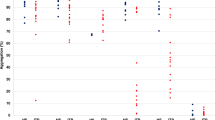Abstract
Flow cytometric evaluation of platelet function extends our understanding of platelets’ role in various clinical conditions associated with either bleeding disorders, thrombosis, or monitoring of antiplatelet therapy. The use of suboptimal concentrations of various agonists may allow assessing the “activatability” of platelets. We determined platelet responsiveness to thrombin-receptor-activating peptide-6, arachidonic acid, adenosine 5c-diphosphate (ADP), epinephrine, collagen, and ristocetin at suboptimal concentrations by determination of P-selectin expression and binding of PAC-1 in 26 healthy male individuals. The response varied considerably from one individual to the next. However, within individuals, responses to all agonists except collagen correlated strongly (p<0.05), suggesting a global variability of platelet responses. Moreover, P-selectin expression and PAC-1 binding were strongly correlated (p<0.05). Interestingly, with epinephrine, PAC-1 positive events outnumbered P-selectin positive events, while this was not seen with the other agonists. Thus, epinephrine may specifically affect the conformational switch mechanism and receptor clustering. Our data indicate that the in vitro response to suboptimal concentrations of agonists varies, but individuals with selective platelet defects may still be identified based on data obtained with the various agonists.

Similar content being viewed by others
References
Deckmyn H, Ulrichts H, Van De Walle G, Vanhoorelbeke K (2004) Platelet antigens and their function. Vox Sang 87(Suppl 2):105–111
Gawaz M (1999) Das Blutplättchen: Physiologie, Pathophysiologie, Membranrezeptoren, antithrombozytäre Wirkstoffe und antithrombozytäre Therapie bei koronarer Herzerkrankung. Georg Thieme Verlag Stuttgard, New York
Goodall AH, Appleby J (2004) Flow-cytometric analysis of platelet-membrane glycoprotein expression and platelet activation. In: Gibbins JM, Mahaut-Smith MP (eds) Platelets and megakaryocytes volume1: functional assays. Methods in molecular biology, vol 272. Humana Press, Totowa, pp 225–253
Kehrel B, Maas M, Kardoeus J (1998) Platelet glycoproteins function and flow cytometric analysis. In: Gutensohn K, Sonneborn H-H, Schunter F, Kühnl P (eds) Flow cytometry in transfusion medicine Clin Lab Publications Heidelberg, pp 1–13
Koksch M, Woinke M (1998) Durchflußzytrometrische Thrombozytendiagnostik. Vom Labor zur klinischen Fragestellung. (mkoksch@beckamcoulter)
Kunicki TJ, Kritzik M, Annis DS, Nugent DJ (1997) Hereditary variation in platelet integrin alpha 2 beta 1 density is associated with two silent polymorphisms in the alpha 2 gene coding sequence. Blood 89:1939–1943
Michelson AD (1994) Flow cytometry: a clinical test of platelet function. Blood 87:4925–4936
Michelson AD, Barnard MR, Hechtman HB, MacGregor H, Connolly RJ, Loscalzo J, Valeri CR (1996) In vivo tracking of platelets: circulating degranulated platelets rapidly lose surface P-selectin but continue to circulate and function. Proc Natl Acad Sci U S A 93:11877–11882
Michelson AD, Barnard MR, Krueger LA, Valeri CR, Furman MI (2001) Circulating monocyte-platelet aggregates are a more sensitive marker of in vivo platelet activation than platelet surface P-selectin: studies in baboons, human coronary intervention, and human acute myocardial infarction. Circulation 104:1533–1537
Nieswandt B, Watson SP (2003) Platelet–collagen interaction: is GPVI the central receptor? Blood 102:449–461
Rao AK, Jalagadugula G, Sun L (2004) Inherited defects in platelet signaling mechanisms. Semin Thromb Hemost 30:525–535
Rosin C, Brunner M, Lehr S, Quehenberger P, Panzer S (2005) The formation of platelet-leukocyte aggregates varies during the menstrual cycle. Platelets, (in press)
Santoso S (2001) Platelet polymorphisms in thrombotic disorders. Transfus Clin Biol 8:261–266
Scharf RE, Tomer A, Marzec UM, Teirstein PS, Ruggeri ZM, Harker LA (1992) Activation of platelets in blood perfusing angioplasty damaged coronary arteries. Flow cytometric detection. Arterioscler Thromb 12:1475–1487
Schmitz G, Rothe G, Ruf A, Barlage S, Tshope D, Clemetson KJ, Goodall AH, Michelson AD, Nurden AT, Shankey TV (1998) European working group on clinical cell analysis: consensus protocol for the flow cytometric characterisation of platelet function. Thromb Haemost 79:885–896
Shattil SJ, Hoxie JA, Cunningham M, Brass LF (1985) Changes in the platelet membrane glycoprotein IIbIIIa complex during platelet activation. J Biol Chem 260:11107–11114
Shattil SJ, Kashiwagi H, Pampori N (1998) Integrin signalling: the platelet paradigm. Blood 91:2545–2557
Stenberg PE, McEver RP, Shuman MA, Jacques YV, Bainton DF (1985) A platelet alpha-granule membrane protein (GMP-140) is expressed on the plasma membrane after activation. J Cell Biol 101:880–886
Tschoepe D (1995) The activated megakaryocyte-platelet-system in vascular disease: focus on diabetes. Semin Thromb Hemost 21:152–160
Yee DL, Sun CW, Bergeron AL, Dong J, Bray PF (2005) Aggregometry detects platelet hyperreactivity in healthy individuals. Blood doi:10.1182/blood-2005-03-1290
Acknowledgements
The authors are grateful to the volunteers who participated in this study. The study was supported in part by a Grant from the Jubiläumsfonds der Österreichischen Nationalbank to S.P.
Author information
Authors and Affiliations
Corresponding author
Rights and permissions
About this article
Cite this article
Panzer, S., Höcker, L. & Koren, D. Agonists-induced platelet activation varies considerably in healthy male individuals: studies by flow cytometry. Ann Hematol 85, 121–125 (2006). https://doi.org/10.1007/s00277-005-0029-5
Received:
Accepted:
Published:
Issue Date:
DOI: https://doi.org/10.1007/s00277-005-0029-5




